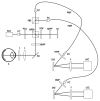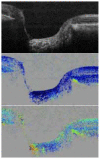High speed spectral domain polarization sensitive optical coherence tomography of the human retina
- PMID: 19503236
- PMCID: PMC2978948
- DOI: 10.1364/opex.13.010217
High speed spectral domain polarization sensitive optical coherence tomography of the human retina
Abstract
We developed a high-speed polarization sensitive optical coherence tomography (PS-OCT) system for retinal imaging based on spectral domain OCT. The system uses two spectrometers, one for each polarization channel, that operate in parallel at 20000 A-lines/s each. It provides reflectivity, retardation, and cumulative optic axis orientation simultaneously. We present our instrument and discuss the requirements for the alignment of the two spectrometers specific for our setup. We show 2D spectral domain PS-OCT images and - to the best of our knowledge - the first 3D spectral domain PS-OCT data sets in form of fly-through movies and volume rendered data sets recorded in human retina in vivo.
Figures









References
-
- Bouma BE, Tearney GJ. Handbook of optical coherence tomography. Marcel Dekker; New York: 2002.
-
- Fercher AF, Hitzenberger CK. Optical Coherence Tomography. Prog. Opt. 2002;44:215–302.
-
- Hee MR, Huang D, Swanson EA, Fujimoto JG. Polarization sensitive low coherence reflectometer for birefringence characterization and ranging. J. Opt. Soc. Am. B. 1992;9:903–908.
-
- de Boer JF, Milner TE, Van Gemert MJC, Nelson JS. Two-dimensional birefringence imaging in biological tissue by polarization-sensitive optical coherence tomography. Opt. Lett. 1997;22:934–936. - PubMed
Grants and funding
LinkOut - more resources
Full Text Sources
Other Literature Sources

